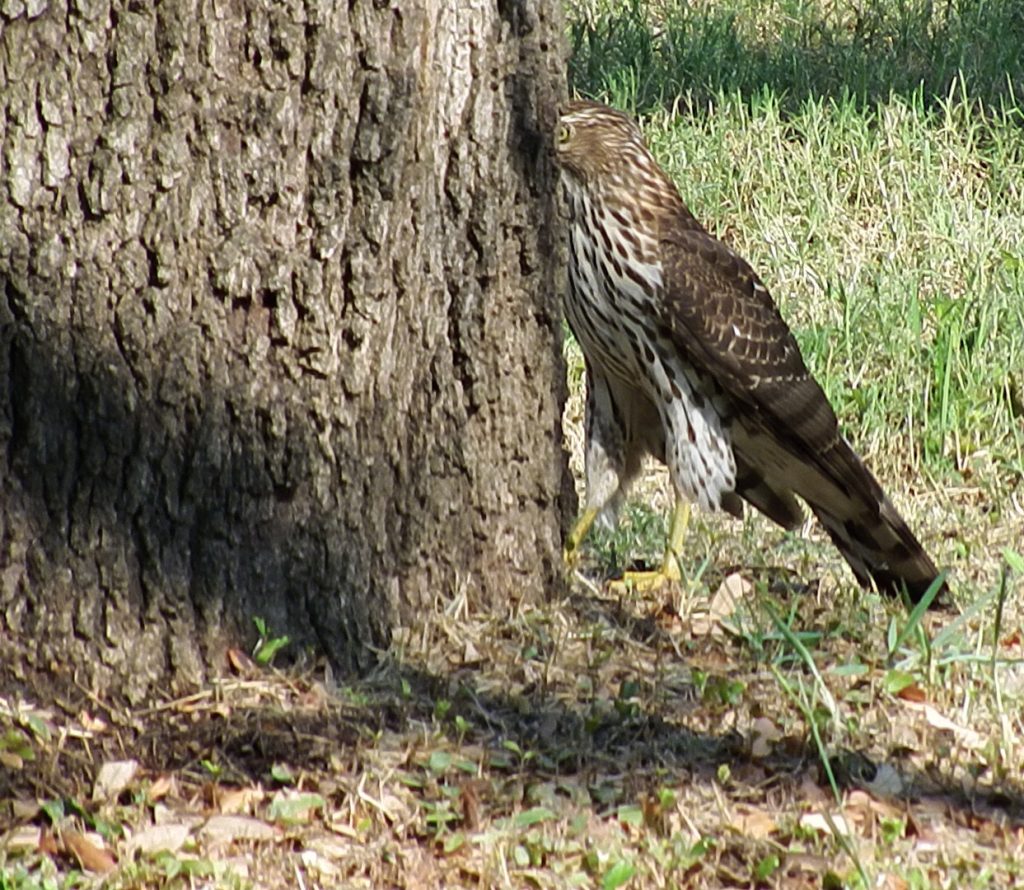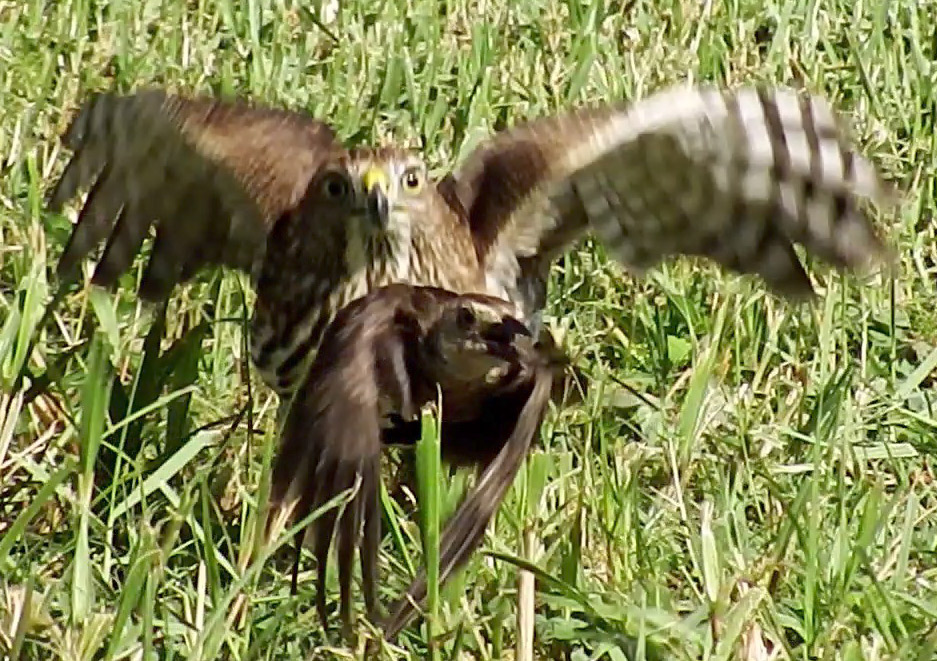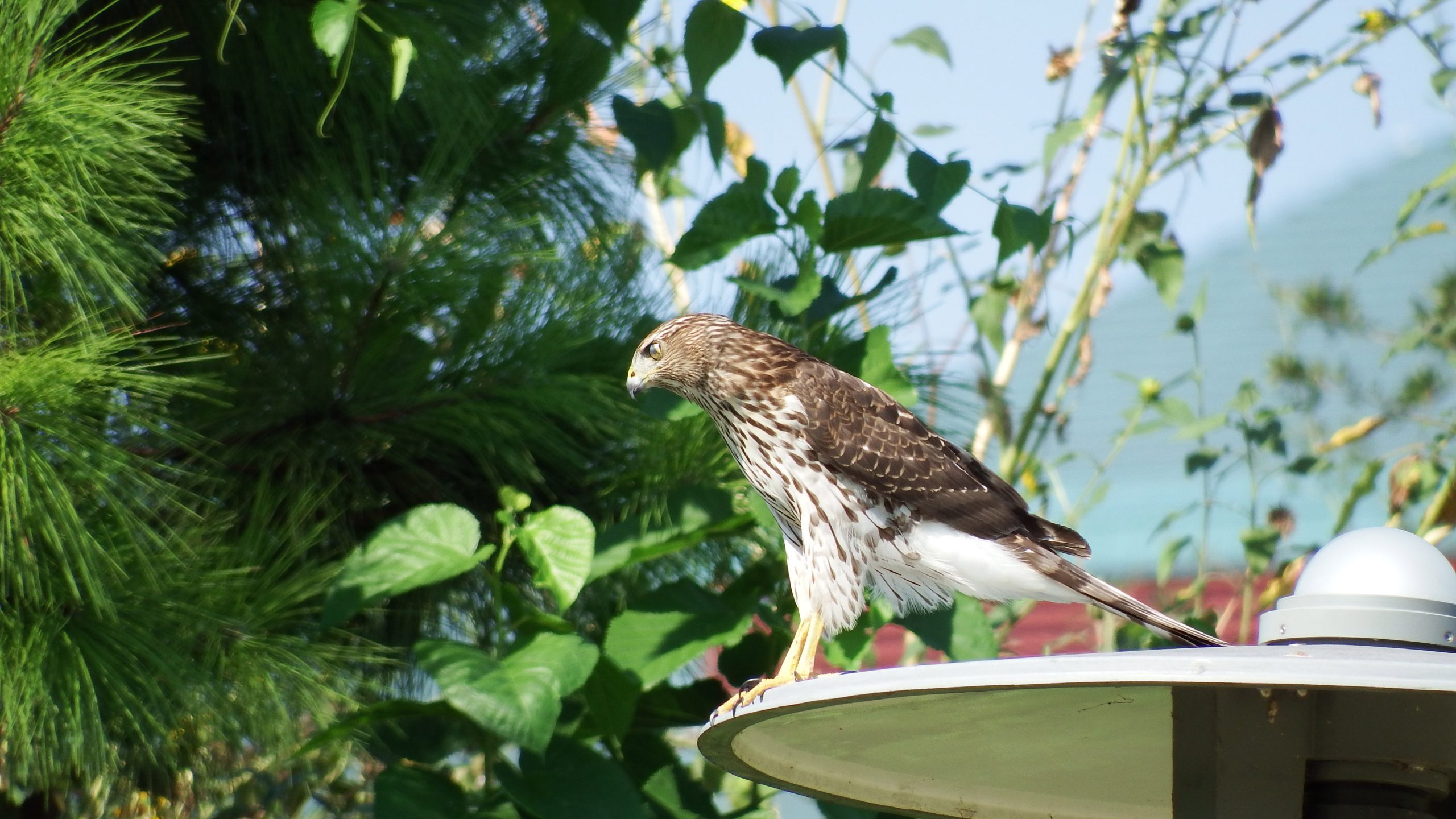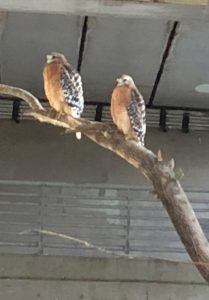Hawk v. Grackle
Baby birds behave in unexpected ways. This is because they are idiots. I have mentioned this before in passing, but this post will be almost entirely about the incompetence of juvenile birds and referring to two in particular: a Coopers Hawk and a Great-Tailed Grackle. It is a heroic tale of peril, escape, and maternal devotion. You can watch it unfold in the video below.
I spotted the hawk sitting on top of a path light next to the trail and I snapped a few photos. It was easy to know that this was a juvenile hawk because of its plumage. All those big spots and streaks on the chest were a very good indicator.
We have always had a pair of Red Shouldered Hawks in the Park. I see them frequently either perched or on the wing. Here they are together under the bat bridge. They are probably the parents of this juvie hawk who is the subject of today’s post. (No they aren’t. The juvenile hawk is a Coopers)*
Red Shouldered Hawk babies leave the nest at about six weeks, but they can’t survive without help until they are 17 to 19 weeks old. Mating season is April to July and it takes about 30 days for the eggs to hatch. That would make this hawk (assuming an early April mating) about 11 weeks old. That is firmly in the period when the baby needs support from its parents to keep from starving to death.
The video illustrates that point; our hawk made nothing but mistakes.

Our juvenile hawk tried to catch the juvenile grackle by chasing it, on foot, around a tree.
The hawk wasn’t the only juvenile bird in this story. The Great-Tailed Grackle is also a juvenile. In the photo at the top of the post, you can see the grackle’s eyes are black; adult grackles have yellow eyes. I began this post by stating that baby birds are idiots. For the grackle, idiocy is a survival strategy.
Before they can fly, songbirds are just snack food for anyone with the ability to get to them. Job one for a baby songbird is to grow feathers and gain enough size and strength to fly. The bird’s brain develops more slowly. As a result, you end up with a bunch of adult-looking birds who can fly but can’t take care of themselves. Their parents still feed and watch over them.
The third player in our drama is never seen, but her voice is heard throughout. That is the voice of an adult grackle (probably one of this bird’s parents) continuously issuing an alarm call. I heard this call long before I noticed the hawk but didn’t pay much attention until the action began in earnest.
By the time I began filming, the hawk was making its third pass around the oak and the baby grackle was already a few feet away from the tree trying to look as dead as possible.
The whole video is about 3.5 minutes. Because of size restrictions on this site, I have edited the video and split it into three chunks. First is the approach. In this clip, the hawk is seeking the grackle who is playing dead a few feet away from the tree. The constant chirping in the background is the parent’s alarm call.
The hawk is getting bolder. He moves closer and closer to the grackle, taking exploratory pecks and placing his foot on the bird. Notice how often he stops to look up. He is worried about that adult grackle who never stops issuing alarm calls.
The final chapter. The hawk boldly, and ineptly goes in for the kill. Notice how shrill the adult grackle is once the action picks up.
I don’t have a video of the full escape but when last seen, our hawk was high in the air chasing the baby grackle while being dive-bombed by the adult grackle. It’s a safe bet that the grackles lived to see another day.
When I watched the video the first time, I was amazed at the incompetence of the hawk. But the more I thought about it, the hawk had a challenging task.
First of all, Coopers Hawks do not hunt on foot. They do frequently feed on other birds, but they usually hunt on the wing or from low perches. That original lamp post, for example. And that Great-Tailed Grackle weighs about 30% of what an adult Coopers weighs. This is the equivalent of a 150 lb man trying to kill a 50 lb dog with bare hands. Dogs have teeth. Grackles have big sharp beaks. It is not a task to be taken lightly.
Since the most exciting part of this video happens very quickly, I wanted to include a slow-mo of just the escape. Mostly because it is cool.
- When I originally posted this, I thought the juvenile hawk was a red-shouldered hawk. It’s amazing how much I’ve learned writing this blog for a few years. When I revisited this post, I realized right away that I had mis-identified the hawk. This juvenile hawk is a coopers, not a red-shouldered. Although the two birds are strikingly similar in appearance, those glowing yellow eyes are the tip-off. Also the head shape. And given that it is a Coopers, it makes more sense that it tried to catch a bird. It was still a comical failure, but a more appropriate one. Edited 2/12/20




